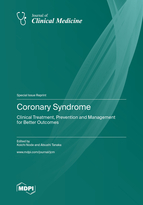Coronary Syndrome: Clinical Treatment, Prevention and Management for Better Outcomes
A special issue of Journal of Clinical Medicine (ISSN 2077-0383). This special issue belongs to the section "Cardiology".
Deadline for manuscript submissions: closed (25 May 2023) | Viewed by 32350
Special Issue Editors
Interests: heart failure; hypertension; atherosclerosis; vascular disease; heart disease
Special Issues, Collections and Topics in MDPI journals
Interests: cardio-metabolic syndrome; preventive cardiology; clinical trial; vascular medicine; heart failure
Special Issues, Collections and Topics in MDPI journals
Special Issue Information
Dear Colleagues,
Coronary artery disease is still one of the major cardiovascular diseases that can impose substantial burdens of clinical and even socioeconomic problems. In addition to the conventional concept of "acute coronary syndrome", the new concept of "chronic coronary syndrome" (revised from "stable coronary artery disease") has become established in recent years. Consequently, there is a strong need to accumulate novel scientific and clinical knowledge in this field to develop seamless treatment and preventive strategies for acute and chronic settings of coronary syndrome. Furthermore, accumulated data have implicated that there are some residual risk factors for coronary syndrome, and clinical management of cardiovascular/non-cardiovascular complications associated with coronary syndrome are also critical issues of concerns for better outcomes. In this Topical Collection, titled “Coronary Syndrome: Clinical Treatment, Prevention and Management for Better Outcomes”, we are calling for papers regarding all types of clinical research to address these unmet clinical needs in the area of coronary syndrome prognosis.
Prof. Dr. Koichi Node
Dr. Atsushi Tanaka
Collection Editors
Manuscript Submission Information
Manuscripts should be submitted online at www.mdpi.com by registering and logging in to this website. Once you are registered, click here to go to the submission form. Manuscripts can be submitted until the deadline. All submissions that pass pre-check are peer-reviewed. Accepted papers will be published continuously in the journal (as soon as accepted) and will be listed together on the special issue website. Research articles, review articles as well as short communications are invited. For planned papers, a title and short abstract (about 100 words) can be sent to the Editorial Office for announcement on this website.
Submitted manuscripts should not have been published previously, nor be under consideration for publication elsewhere (except conference proceedings papers). All manuscripts are thoroughly refereed through a single-blind peer-review process. A guide for authors and other relevant information for submission of manuscripts is available on the Instructions for Authors page. Journal of Clinical Medicine is an international peer-reviewed open access semimonthly journal published by MDPI.
Please visit the Instructions for Authors page before submitting a manuscript. The Article Processing Charge (APC) for publication in this open access journal is 2600 CHF (Swiss Francs). Submitted papers should be well formatted and use good English. Authors may use MDPI's English editing service prior to publication or during author revisions.
Keywords
- acute coronary syndrome
- chronic coronary syndrome
- percutaneous coronary intervention
- coronary artery bypass grafting
- treatment
- risk factors
- prevention
- complications
- outcomes







